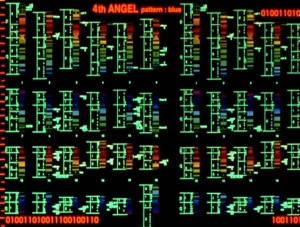Particle-Wave Matter: Difference between revisions
No edit summary |
m (I'm getting pissed off at these stubs...) |
||
| Line 29: | Line 29: | ||
[[Category:A to Z]] | [[Category:A to Z]] | ||
[[Category:Terminology]] | [[Category:Terminology]] | ||
Revision as of 07:43, 26 February 2008

"Particle-wave matter" is the unidentified substance that Angels (and thus, the Evangelions) are composed of. It is not simply an unknown chemical substance: the basic atomic structure of the matter Angels are composed of is different from anything previously encountered by human science.
As Dr. Ritsuko Akagi explains in Episode 05 after analysis of the corpse of the Angel Shamshel:
- "We do know the Angel is composed of a type of matter characterized by both particulate and wave properties, like light."
Essentially, Matter tends to behave as particles (discrete individual units), while Energy (all electromagnetic radiation including light) behaves as waves (waves of energy). However, Einstein won the Nobel Prize for proving that Energy behaves as both waves and particles. The basic units of Energy are "photons", discrete packets of Energy which cannot be further subdivided. Later, it was discovered that Matter actually behaves as waves too: according to the Heisenberg Uncertainty Principle, electrons move around an atom in such a way that while a discrete "particle", the exact location and direction of a single electron cannot be determined at the same time (this is why the "cloud" model is often used to represent electrons), and they do behave like a wave. Later, it was discovered that Protons and Neutrons also behave somewhat like a wave, but their motion is incredibly small and negligible, due to their much greater mass than electrons (one proton has well over a thousand times greater mass than an electron). Photons apparently have no mass (though it might just be so small that scientific instruments cannot detect it).
Wave-particle duality can basically be thought of on this spectrum: Proton --> Electron -----> Photon
- Proton: heavy mass = behaves almost entirely like a particle, with negligible wave properties
- Electron: small mass = behaves mostly like a particle, but has distinct wave-like behavior
- Photon: no (or almost) no mass = behaves like a wave, with particle-properties in that it cannot be infinitely subdivided into smaller units
The "particle-wave matter" that Angels (and Evas) are composed of would, based on Ritsuko's description, appear to be somewhere on the spectrum between Electrons and Photons: it's not quite what we'd strictly define as "Matter" and not quite what we'd strictly define as "Energy", but falls between the two. It has above-negligible mass (though not as much mass as electrons), but more photon-like wave-behavior than electrons. The result would look like: Proton --> Electron --> "Particle-wave matter" --> Photons
Ritsuko goes on to explain that:
- "Although (the Angels) are composed of a different form of matter, their actual composition, in terms of the arrangement and spacing of the pattern, falls within a 99.89% match of human genes"
Essentially, while the "atoms" which Angels are made of are not what we would consider "normal" matter (they don't even seem to be composed of an arrangement of protons, neutrons, and electrons), the structure of the "molecules" into which "atoms" of particle-wave matter are arranged is an almost exactly the same as certain molecule forms found in terrestrial life forms, specifically the arrangement of human genetic molecules. Ritsuko refers to results of her scan of the Angel's particle-wave matter as displaying the Angel's "inherent wave pattern".
Notes
- This article's subject does not have any known canonical designation. "Particle-wave matter" is a fan-created term based on Ritsuko's quote.
- Wave-particle duality is a real-world scientific principle.
